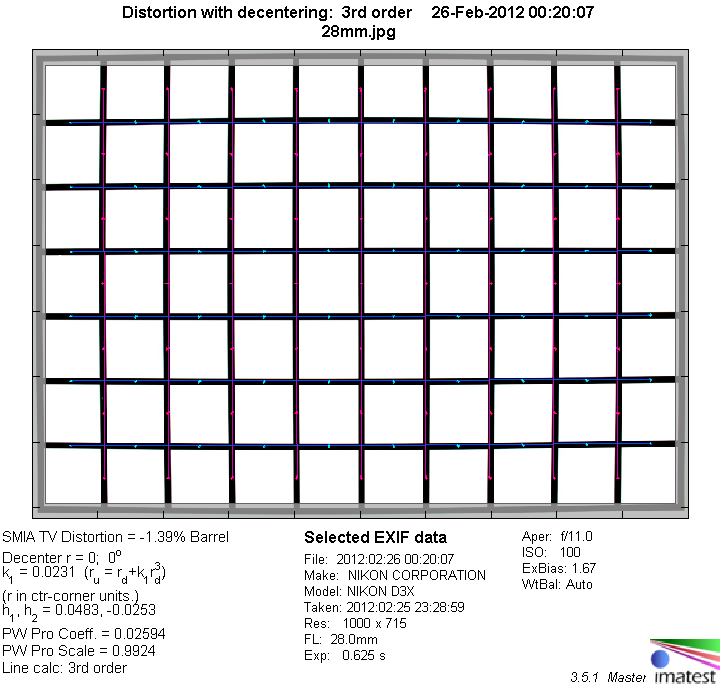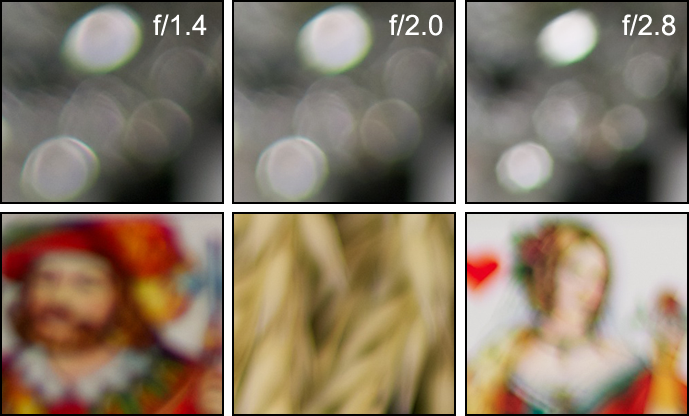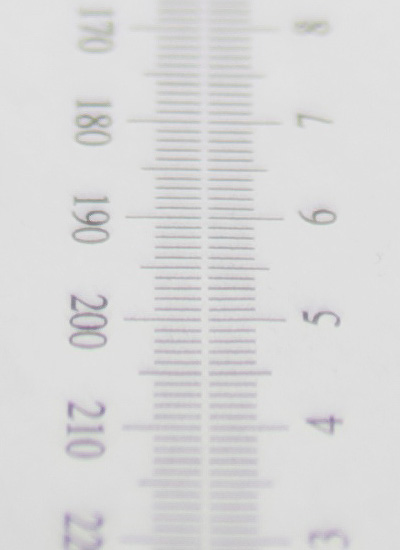|
Page 2 of 3

Distortion
The lens shows a moderate amount of barrel distortion which can be visible in critical shots especially with straight lines near the image borders. However, the distortion is uniform and easy to correct in post processing.

The chart above has a real-world size of about 120x80cm.
Vignetting
Fast lenses tend to suffer from high vignetting on full frame cameras and the AF-D 28/1.4 is no exception in this regard. In fact, with just above 2.1 EV wide open the light fall-off towards the image corners is very pronounced and of course clearly visible in the final image (see the sample image section on the next page for examples). Stopping down helps to reduce vignetting, but even at f/2 the amount of vignetting remains rather high. From f/2.8 onwards vignetting is no longer relevant, except for really critical scenes.
We're performing our vignetting analysis based on
(uncorrected) JPEGs straight from the camera. The JPG engine of the Nikon D3x features a rather flat
gradation curve, thus has a moderate contrast characteristic, resulting in comparatively low vignetting figures - the
corresponding Canon figures are roughly 40% higher due to the more
aggressive default contrast setting.

MTF (resolution)
The center resolution is very good already at the largest aperture. However the lens shows reduced contrast at this aperture setting as well as what is often described as "glow" around contrast edges. This behaviour is typical for many classical ultra-fast lenses. Stopped down, the resolution (and contrast) increases and reaches excellent level from f/2.8 onwards.
The borders and corners follow one step behind, with good resolution wide open and moderately stepped down. From f/5.6 onwards the resolution reaches very good values here. Surprisingly, the extreme corners always performed slightly better than the image borders throughout the tested aperture range.
Please note that the MTF results are not directly comparable across the different systems!
Below is a simplified summary of the formal findings. The chart shows line widths
per picture height (LW/PH) which can be taken as a measure for sharpness.
If you want to know more about the MTF50 figures you may check out the corresponding
Imatest Explanations

Chromatic Aberrations (CAs)
Chromatic aberrations (color shadows at harsh contrast transitions) range from abive 1.5 to almost 1.9 pixels at the image borders throughout the tested aperture range. This might be visible in very large prints (or crops). However, CAs can easily be corrected in software or by the camera itself (most modern Nikon DSLRs remove CAs themselves if you shoot JPGs).

Bokeh
One of the primary usage scenarios for a large aperture lens is to separate the main subject from the background. In such an image the quality of the bokeh (out-of-focus blur) is of major significance.
In front of the focal plane the bokeh is quite smooth, however for most real-world shots, especially with a wide angle lens, that's mostly irrelevant. The more important area behind the focal plane shows a rather nervous blur characteristic.
Background highlights show a cat's eye shape due to mechanical vignetting at the largest aperture, which is typical for fast lenses. In addition, there's a fair amount of outlining, which increases the impression of nervousness. Stopped down, the outlining is reduced, but the shape of the aperture blades becomes visible.

Bokeh Fringing
Bokeh fringing (non-coinciding focal planes of the various colors) is a common issue with relatively fast glass. As you can
notice below, the halos have different colors - magenta (red + blue) in front the focus point
and green beyond. Truly "apochromatic" lenses don't show this kind of fringing but these lenses are very rare especially
below 100mm. Unlike lateral lateral CAs, bokeh fringing cannot easily be fixed in post processing.
Typical for most fast primes, especially ultra fast ones, the AF-D 28/1.4 shows some amount of fringing at large aperture settings, which can of course be reduced by stopping down.
In addition, these shots show the "glow" around contrast edges as well as the lack of contrast at large apertures (which is pronounced in these images due to the very short focus distance) as already mentioned in the MTF section.
|
Move the mouse cursor over the f-stop marks below to observe the respective LoCAs
|
| f/1.4 |
f/2 |
f/2.8 |
f/4 |
f/5.6 |
|

|
|